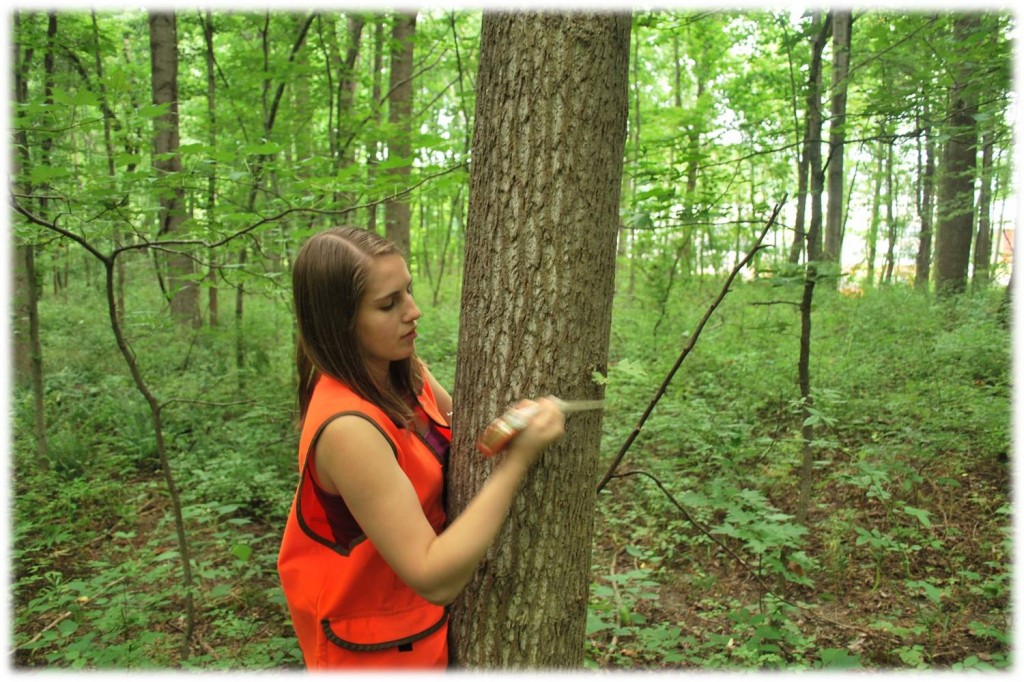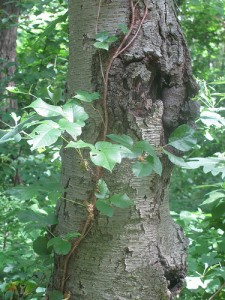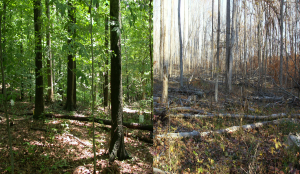By Katie Sinclair

Intern Hope Zabronsky measures the diameter of a tree to see how logging affects biomass regeneration
Summer is almost over, which means intern season is coming to a close. Over 20 interns from universities across the United States have spent their summers here at SERC, studying everything from phytoplankton to Phragmites. Several interns chose to take on the challenge of climate change, exploring how trees will affect rising levels of greenhouse gases.
Mysterious Methane
Although methane emissions worldwide are much lower than CO2 emissions, a little methane goes a long way: Methane is 25 times as powerful a greenhouse gas as CO2. While we have an idea of what the sources of methane are, researchers face difficulties when trying to model methane emissions. The biggest discrepancy is between “top-down” and “bottom-up” models. Top-down approaches use satellite imagery to track the amount of methane in the atmosphere, while bottom-up methods look at the amount of methane emitted from the soil.
The Biogeochemistry Lab wants to see if methane is coming from sources other than the soil. Marsh grasses are known to emit methane, but no research has yet been done on trees. Figuring out if and how much methane is emitted can help determine whether methane projections are accurate. The Biogeochemistry Lab has set up two experimental sites to study methane, and is working on establishing a third.
Intern Kyle King worked on methane emissions this summer. He attached airtight chambers to trees, and measured the gas concentrations at different heights along the tree. He found that trees did emit methane, in some cases more than microbes in the soil. Methane emissions were highest near the roots and less at higher trunk heights. He also found that larger trees emitted much more methane than smaller ones.
The exact mechanism of how trees release methane is not yet understood. Two possibilities are methane diffusing out of the water that is taken in by the plants’ roots, or microbes inside the tree producing methane. But whatever the cause, understanding where methane comes from will be vital when trying to predict the impact of climate change.
Tree Growth and Logging
Hope Zabronsky, interning with the Forest Ecology Lab, wanted to see whether trees growingin logged versus unlogged forests had different growth rates. 50 percent of a tree’s biomass is carbon, so understanding what conditions impact a tree’s growth can help determine how much carbon a tree is storing from the atmosphere. Hope looked at immature and mature forest stands in both logged and unlogged areas on the SERC property. She measured every tree with a trunk diameter over 5 cm in her four plots (that’s over 2500 trees!). After analyzing her data, Hope found that trees in the logged plots had lower growth rates than trees in the un(?)logged plots. She also found that tulip poplars had the fastest growth rate. Figuring out how past land use affects the rate that trees put on biomass is important when determining possible “carbon credits” for reforestation, according to Hope. It’s necessary to know which species is most efficient at converting CO2 into biomass under certain conditions.
Vines vs. Trees
While trees may be the big players in climate change, Emma Edwards, also interning with the Forest Ecology Lab, turned her attention to a lesser-studied plant: vines. Studies show that as CO2 rises, vines may become more abundant. Poison ivy, for example, will have higher growth rates and become even more noxious. The Forest Ecology Lab has charted the location of and tagged every woody plant—over 34,000—in SERC’s 16-hectare Smithsonian Institution Global Earth Observatory (SIGEO). SIGEO is divided into multiple plots, and allows scientists to study several topics, including succession, species distribution, and nutrient flow. Emma wanted to see if vines had a preference for particular tree species and habitats.

Hairy vine, no friend of mine! Climate change could make poison ivy more noxious. (photo credit: edenpictures/Flickr)
Vines take advantage of a tree’s structure to access sunlight and other nutrients, which can impair tree growth. Emma focused on the most abundant vine species: poison ivy, grapevine and honeysuckle. She found that vine species do prefer certain tree species, and that poison ivy is more common in wetter lowland areas (luckily for Emma, she’s not allergic to poison ivy). Emma’s vine study was the beginning of a longer-term effort to better understand the interaction between trees and vines. Usually as a forest matures, vines become less common: vines are short-lived, and are unable to twine around larger-diameter trees. However, over the next few decades, climate change could result in vine species becoming more common, even in older forests. Because vines in temperate regions have not been studied extensively, there will be many opportunities for future SERC scientists to continue Emma’s work on vines.
Interns in the Biogeochemistry Lab and Forest Ecology Lab have put in long hours, battling mosquitoes, mud and poison ivy. Their work at SERC will better help us understand forest dynamics, as well as offer insight into how forest ecosystems will play a role in climate change.


